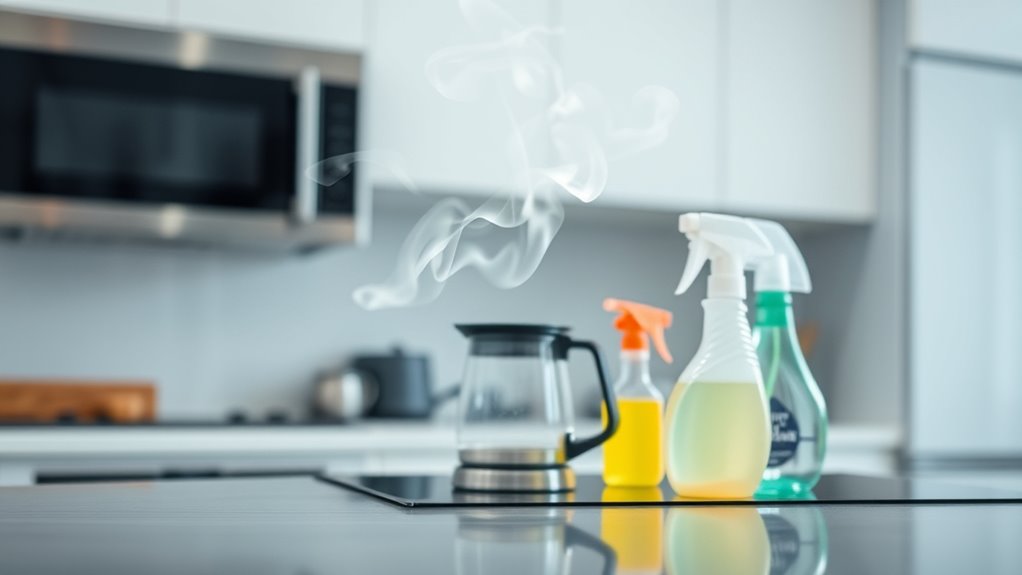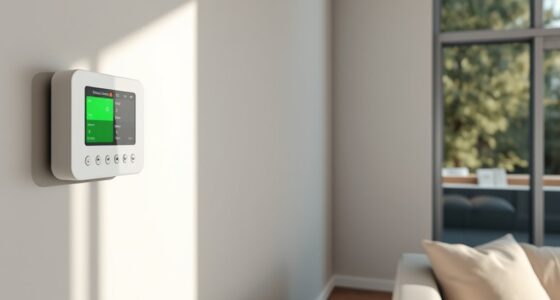VOCs, or volatile organic compounds, are chemicals that easily turn into vapors at room temperature, which can impact the air you breathe indoors. They come from common sources like paints, cleaning supplies, furniture, and personal care products. These emissions can affect your health by causing irritations or long-term issues. Understanding where VOCs originate helps you make smarter choices for a healthier space. Keep exploring to uncover simple ways to reduce your exposure and improve indoor air quality.
Key Takeaways
- VOCs are chemicals that easily vaporize at room temperature, contributing to indoor air pollution.
- Common sources include household products, paints, cleaning supplies, furniture, and personal care items.
- They can cause health issues like irritations and long-term illnesses with prolonged exposure.
- Increasing ventilation and choosing low-VOC products help reduce indoor VOC levels.
- Managing VOCs improves indoor air quality, creating a healthier environment for occupants.

Have you ever wondered what VOCs are and why they matter? If you’re concerned about your health and the air you breathe every day, understanding volatile organic compounds (VOCs) is a good place to start. VOCs are a group of chemicals that easily vaporize at room temperature, releasing emissions into the air. These chemical emissions can markedly impact indoor air quality, which is often overlooked compared to outdoor pollution. When VOCs are present in your home or workspace, they can contribute to a range of health issues, from minor irritations to more serious long-term effects. Recognizing their sources and how they affect your environment helps you make smarter choices to keep your indoor air safe.
Understanding VOCs helps you make healthier choices for cleaner indoor air.
VOCs come from a variety of common household and building materials and products. Many of these items emit chemical emissions during use and even after they’ve been put away. For example, paints, varnishes, and cleaning supplies release VOCs as they dry or evaporate. Personal care products like hairsprays, perfumes, and air fresheners also contribute to indoor VOC levels. Even new furniture and carpeting can emit chemical emissions, especially if they’re treated with chemicals like flame retardants or adhesives. These emissions aren’t just a fleeting concern—they can linger in the air for days or weeks, continuously adding to the concentration of VOCs in your environment.
Understanding where these chemical emissions originate allows you to take steps to reduce your exposure. Ventilation is key; opening windows and using exhaust fans can help disperse VOCs and improve indoor air quality. Choosing products labeled low-VOC or VOC-free can make a noticeable difference. When shopping for household items, look for certifications and labels that indicate fewer emissions. Proper storage of chemical products in sealed containers also minimizes their release into the air. Regular cleaning can help remove surface residues that might off-gas over time. Additionally, maintaining a consistent indoor temperature and humidity level can reduce the rate at which VOCs are released from materials.
Being aware of the sources of VOCs helps you better control your environment and protect your health. By understanding how chemical emissions contribute to indoor air quality, you gain the power to make informed decisions—like opting for greener products, increasing ventilation, and reducing the use of items that emit VOCs. This proactive approach not only improves the air you breathe but also creates a healthier, safer space for you and your loved ones. Ultimately, managing VOCs is a simple but impactful step toward a cleaner, fresher indoor environment.
Frequently Asked Questions
How Can I Detect VOCS in My Home?
You can start with DIY detection by using at-home VOC test kits, which are affordable and easy to use. These kits typically involve collecting air samples and sending them to a lab for analysis. For more accurate results, consider professional testing, where experts use specialized equipment to detect VOC levels precisely. Both methods help you identify if VOCs are present in your home and guide you on necessary steps to improve indoor air quality.
Are VOCS Harmful to Pets?
Thinking about VOCs is like worrying about hidden shadows. They can be harmful to your pet’s health, especially with repeated toxin exposure. Pets are more sensitive to airborne pollutants, so VOCs might cause respiratory issues or allergic reactions. To protect your furry friends, guarantee proper ventilation and choose low-VOC products. Keeping your home well-ventilated helps reduce VOC levels, safeguarding your pet from potential harm and supporting their overall well-being.
What Are Natural Sources of VOCS?
Natural sources of VOCs include indoor plants, which emit natural emissions that add to your home’s air. These plants release small amounts of volatile organic compounds as part of their biological processes. Additionally, outdoor sources like trees and soil contribute to VOC levels, especially during warm weather. While these emissions are generally harmless, it’s good to be aware of them, especially if you’re sensitive to air quality issues indoors.
How Do VOC Levels Vary Seasonally?
Imagine VOC levels dancing to the rhythm of the seasons. During winter, you might notice lower outdoor pollution because fewer activities release VOCs, and colder temperatures slow their dispersal. In contrast, summer’s warmth boosts emissions from vehicles and plants, causing seasonal fluctuations. These variations markedly influence indoor air quality, making it essential to stay aware of outdoor pollution patterns throughout the year to better manage VOC exposure.
Can Air Purifiers Fully Remove VOCS?
You might wonder if air purifiers can fully remove VOCs. While they help improve air quality, their effectiveness varies based on the purifier type and VOC levels. Regular VOC monitoring is essential to assess your home’s air, but no purifier can eliminate all VOCs completely. Use a high-quality purifier designed for VOCs, and combine it with good ventilation for the best results in reducing harmful compounds.
Conclusion
Understanding VOCs helps you make healthier choices for your home and environment. Did you know that indoor air can be up to five times more polluted than outdoor air, largely due to VOCs? By being aware of common sources like paints and cleaning products, you can reduce your exposure. Staying informed empowers you to create a safer, cleaner space for yourself and your loved ones. Small changes today can lead to a healthier tomorrow.









